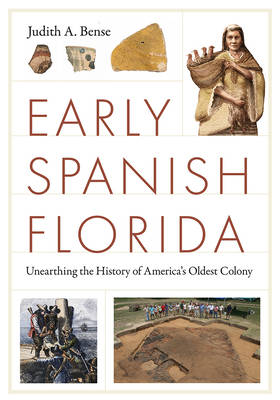
- Afhalen na 1 uur in een winkel met voorraad
- Gratis thuislevering in België vanaf € 30
- Ruim aanbod met 7 miljoen producten
- Afhalen na 1 uur in een winkel met voorraad
- Gratis thuislevering in België vanaf € 30
- Ruim aanbod met 7 miljoen producten
Omschrijving
A leading authority on the archaeology of Florida tells the story of the state's past as a Spanish colony
Florida is the state with the oldest recorded history of European contact, beginning with the arrival of Spanish explorer Juan Ponce de León more than five centuries ago--but many people don't know the full story of Florida during this momentous time. Engagingly written and extensively illustrated, Early Spanish Florida delves into archaeological discoveries to uncover the 250-year history of Spanish colonization on the peninsula.
Judith Bense, a lifelong archaeologist and expert on Spanish Florida, traces the story from 1513 when Ponce de León accidentally landed on "La Florida" to 1763 when Spain lost the land to Britain after the Seven Years' War. Bense explores how the first Spanish settlers tried to colonize Florida with aims to take over the entire Southeast, encountering harsh weather, competing colonizing nations, and Native resistance. The story includes the establishment of St. Augustine in 1565, shipwrecks of early explorers and colonists, the building of Catholic missions in the 1600s, and the journeys of people of African descent escaping slavery on northern plantations.
The events in Early Spanish Florida are told from the perspectives of the intertwined groups of people whose interactions created deep cultural changes, including Spanish, Indigenous, and African communities. Filled with maps and images of artifacts, excavations, historical sites, and original documents, and featuring suggested readings and places to visit, this book offers a wealth of knowledge and sparks enduring interest in Florida's past.
Funding for this publication was provided through a grant from Florida Humanities with funds from the National Endowment for the Humanities. Any views, findings, conclusions, or recommendations expressed in this publication do not necessarily represent those of Florida Humanities or the National Endowment for the Humanities.
Specificaties
Betrokkenen
- Auteur(s):
- Uitgeverij:
Inhoud
- Aantal bladzijden:
- 220
- Taal:
- Engels
- Reeks:
Eigenschappen
- Productcode (EAN):
- 9780813081489
- Verschijningsdatum:
- 3/03/2026
- Uitvoering:
- Paperback
- Formaat:
- Trade paperback (VS)
- Afmetingen:
- 178 mm x 254 mm

Alleen bij Standaard Boekhandel
Beoordelingen
We publiceren alleen reviews die voldoen aan de voorwaarden voor reviews. Bekijk onze voorwaarden voor reviews.








